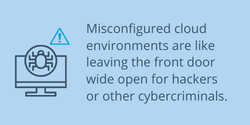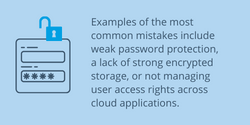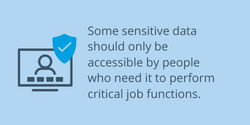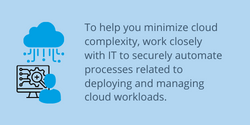
23 Aug 3 Ways to Protect Your Data from Cloud Misconfiguration
IT modernization is a common business initiative for all types of organizations, and the road to modernization almost always leads through the cloud.
According to CIO’s, migrating to the public cloud or expanding private clouds is their top IT spending driver (Deloitte 2020). Cloud computing makes it easier to shift workloads to the cloud, which helps companies transform their operations faster and improve business resiliency.
Moving to the cloud could help you speed up your IT without compromising security, but there are risks involved.

To avoid any potential security risks associated with using cloud services, it’s important to understand the different types of cloud security threats and their impact on your business.
We will look at what cloud misconfiguration means and best practices for protecting your business against cloud-based data breaches.
What is Cloud Misconfiguration?
Cloud misconfiguration occurs when you put sensitive data and other information into cloud environments without properly securing them or without giving consideration to overall data integrity, encryption, and availability.
Cloud security risks are rapidly growing in importance. Technological research and consulting firm Gartner Inc. forecasts in its Future of Cloud 2025 report that 99% of cloud breaches will be due to mistakes made by the user.

Simply stated, cloud misconfiguration is a data governance problem.
Cloud misconfigurations become more serious when you let the number of cloud services you rely on to grow. As you add more cloud services to your business, the more your sensitive customer data is spread out making it vulnerable to bad actors.
This isn’t a warning against using the right cloud services for your business needs; instead, it’s a reminder to have a clear policy regarding which employees get access to which cloud services and how they’re used.
How Can You Protect Your Data from Cloud Misconfiguration?
Cloud misconfiguration isn’t just a theoretical risk; it can be a real threat. However, there are proven ways to minimize its impact by organizing and securing cloud services.
Here are some best practices for protecting your data from cloud misconfigurations:

First, determine which data needs which levels of cloud security.
Obviously, data that is useful for everyone in your organization should be made available to everyone. However, some sensitive data should only be accessible by people who need it to perform critical job functions.
It’s important to note that failing to clearly define data lifecycle policies for every cloud workload is a very common mistake that puts sensitive data at risk.
But once the correct lifecycles and policies are established and the IT department has the policies in place, it becomes much easier to manage who has access to and who can potentially modify cloud infrastructure as an important aspect of maintaining data security.
2. Regularly review your cloud apps and API defaults for security gaps.
Make sure your IT department knows the default configurations for all cloud services and applications you use.
Each cloud provider has its own set of defaults, settings, and service level agreements (SLA). This helps you identify potential security gaps in cloud infrastructures and adopt policies or technologies to address them.
With an end-to-end view of your cloud security, you’ll be able to design the right audit provisions, reporting processes, and incident response procedures to quickly identify any potential threats.

Complexity and compliance failures are two key reasons why data breaches are costly for companies. To help you minimize cloud complexity, work closely with IT to securely automate processes related to deploying and managing cloud workloads. Doing so allows you to define secure lifecycles and follow them automatically.
With this unified approach, you’ll be able to simplify your cloud workflows, ensuring that cloud resources are provisioned properly and accessed securely.
An Experienced Cloud Vendor Eliminates Cloud Misconfiguration Risks
Working with an established cloud vendor, like CyberlinkASP, who values interoperability and security is also beneficial.
We use a reliable and tested suite of products designed to minimize your security risks, control your IT costs, provide 99.9% system uptime, and increase employee productivity.
Looking to stop your cloud data leaks? Give us a call today.